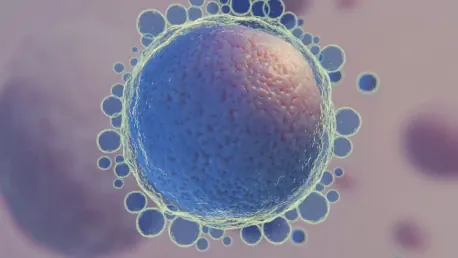For lymphoma patients, particularly those facing relapsed or refractory large B cell lymphoma (LBCL), CAR T cell therapy represents a beacon of hope. This promising treatment, epitomized by Breyanzi (lisocabtagene maraleucel), offers a new avenue for those who have exhausted conventional treatment options. The transformative potential of CAR T cell therapy can be seen through the personal journeys of two individuals, Jenna and Dean, who faced daunting battles with LBCL and ultimately found hope in this advanced and personalized approach.
The Emotional Rollercoaster of Lymphoma
Jenna’s ordeal began in December 2021, a period marked by dread and a sense of impending finality as she faced a relapse amidst the festive season following chemotherapy. Each setback eroded her morale, but her determination remained steadfast. Despite the relentless cycle of treatments that offered no reprieve, Jenna consented to try Breyanzi, pinning her last hopes on this novel therapy. The treatment process was exhaustive and rigorous, entailing blood collection, genetic modification of her T cells, followed by infusion and meticulous monitoring for side effects. The emotional toll was immense, yet the promise of a personalized therapy approach rekindled a flicker of hope in her fight against the relentless progression of her disease.
Dean’s journey with non-Hodgkin lymphoma began in 2018 following a painfully unexpected episode that led to his diagnosis. Despite initial chemotherapy, the shadow of his illness lingered, casting doubts and questions about his future. The path became even more arduous in 2021, with a prostate cancer diagnosis compounding his struggle and a subsequent relapse of his lymphoma. The aggressive chemotherapy yielded no results, plunging Dean into a state of despair. Nevertheless, undeterred and encouraged by his doctor, Dean turned to CAR T cell therapy with Breyanzi. This novel treatment represented his final hope after conventional therapies had failed to curb the disease’s progression.
Understanding CAR T Cell Therapy
CAR T cell therapy stands as a groundbreaking advancement in cancer treatment. This revolutionary approach involves extracting a patient’s T cells, a specific kind of white blood cell, from their blood. These cells are then genetically modified to recognize and target cancer cells and subsequently reintroduced into the patient’s body. This personalized therapy harnesses the body’s immune system to fight cancer more effectively than traditional methods like chemotherapy and stem cell transplants. By tailoring treatments to the unique characteristics of a patient’s cancer, CAR T cell therapy offers a promising pathway for those with hard-to-treat forms of lymphoma.
Breyanzi is typically used after multiple conventional therapies have failed, marking a last line of defense for patients. The meticulous process of CAR T cell therapy involves several stages, starting with the collection of the patient’s blood. This is followed by the creation of CAR T cells, where the cellular genetic modification occurs. After the modified cells are ready, they are infused back into the patient, where they begin their targeted attack on the cancer cells. The entire process requires close and continuous monitoring to manage any side effects that may arise. This cutting-edge personalized treatment has opened new doors for remission in patients who previously had few options left.
The Mechanism of Breyanzi
Central to the success of CAR T cell therapy is the mechanism by which Breyanzi operates. The process initiates with the extraction of T cells from the patient’s blood. These cells are then genetically engineered to produce chimeric antigen receptors (CARs) on their surfaces. These receptors are designed to recognize and bind to a specific protein found on the surface of cancer cells, effectively directing the T cells to their targets. This advanced genetic engineering enables T cells to home in on cancer cells with precision, increasing the efficacy of the treatment while minimizing damage to healthy cells.
After the modified CAR T cells are created, they are infused back into the patient’s body. Here, these engineered cells commence their mission, seeking and destroying the cancer cells. The precise targeting mechanism of Breyanzi allows for a more focused attack, significantly boosting the potential for remission compared to traditional treatments. This innovative approach capitalizes on the body’s immune system in a manner that offers a bespoke and potent therapeutic option for lymphoma patients. The personalization of this treatment means that it is specifically tailored to each patient, adapting to the unique characteristics of their individual cancer.
Navigating the Risks and Side Effects
Despite its groundbreaking potential, CAR T cell therapy comes with a significant risk of severe side effects. Both Jenna and Dean encountered these daunting side effects, which included cytokine release syndrome (CRS), an intense immune response that can lead to fever and other serious symptoms. The risk of infections soared due to the lowered counts of white blood cells, presenting an additional challenge during their treatment. Neurologic toxicities also posed a threat, adding to the complexities of care and requiring vigilant medical oversight. Nonetheless, despite these considerable risks, Jenna and Dean regarded CAR T cell therapy as their best and possibly last hope.
Jenna, for instance, faced symptoms of CRS shortly after her treatment but was under the constant watchful care of her medical team. This vigilance was crucial in managing and mitigating the side effects of her treatment, ensuring that any complications could be swiftly addressed. Dean, on the other hand, experienced viral infections post-treatment, necessitating intensive monitoring to manage his weakened immune state. Their experiences underscore the importance of a robust support system combined with dedicated medical care to navigate the treacherous landscape of side effects accompanying CAR T cell therapy. The journey, though fraught with challenges, offers a beacon of potential remission that makes the risks worth bearing for many patients.
Achieving Remission and Renewed Hope
A month after undergoing treatment with Breyanzi, Jenna received life-changing news—she was in remission. This breakthrough came just before Christmas, rendering it a poignant and memorable event. The possibility of facing the new year cancer-free was a testament to the profound impact of CAR T cell therapy. Jenna now enjoys a future filled with everyday moments and cherished time with her daughter. Her journey didn’t stop with her remission; she frequently supports others battling similar challenges through online communities, offering hope and inspiration.
Dean, too, saw the fruits of his endeavor thirty days post-treatment when his scans revealed remission. The relief and joy brought by this news reinvigorated his life. Today, he basks in the simple pleasures of family life, cherishing every moment with his daughters and grandchildren. The resilience and hope in stories like Dean’s affirm the transformative potential of CAR T cell therapy. Both Jenna and Dean’s experiences emphasize the emotional and physical renewal that comes with successful treatment, highlighting how the journey through CAR T cell therapy, despite its harrowing aspects, can lead to life-affirming outcomes.
The Importance of Support Systems
Throughout their arduous journeys, both Jenna and Dean highlighted the critical role of support systems. Family, friends, and online communities provided invaluable emotional and psychological support, making the difference between despair and hope. For Jenna, her support network included her devoted daughter and the online forums where she engaged with others facing similar battles. These interactions not only gave her strength but also allowed her to offer hope and guidance to others. It was this mutual exchange of support and resilience that played a pivotal role in her journey toward remission.
Dean’s support system was equally vital, consisting of his wife, Mary, and his close-knit family. Their unwavering encouragement helped him navigate the numerous challenges posed by his diagnosis and subsequent treatments. Dean’s family provided not only emotional support but also practical help, such as accompanying him to medical appointments and assisting with his care during treatment. The emphasis on support systems in their stories underscores a broader consensus within the medical community: the journey through severe illnesses like lymphoma is not just a medical challenge but a profoundly personal and emotional ordeal that necessitates a robust and compassionate support network.
The Future of CAR T Cell Therapy
For patients battling lymphoma, especially those dealing with relapsed or refractory large B cell lymphoma (LBCL), CAR T cell therapy shines as a beacon of hope. This cutting-edge treatment, exemplified by Breyanzi (lisocabtagene maraleucel), provides a new option for individuals who have exhausted traditional treatments. The innovative potential of CAR T cell therapy is vividly illustrated through the personal stories of Jenna and Dean. Both individuals faced intense challenges with LBCL, yet they ultimately found renewed hope and progress through this advanced, customized approach.
Jenna’s journey began with a diagnosis of LBCL that did not respond to initial treatments. After multiple rounds of chemotherapy and radiation, her doctors recommended CAR T cell therapy. Despite her initial apprehensions and the rigorous process, she embraced this new treatment. Similarly, Dean’s battle with LBCL led him through numerous conventional therapies, none of which proved effective. When he turned to CAR T cell therapy, the results were remarkable. Treatments like Breyanzi reprogram a patient’s T cells to target and destroy cancer cells, offering a personalized and highly effective solution where other therapies have failed.
CAR T cell therapy’s success stories, like those of Jenna and Dean, underscore its potential to revolutionize lymphoma treatment. It’s a tailored approach that provides new possibilities for patients who had little hope left, paving the way toward better outcomes and improved lives.









